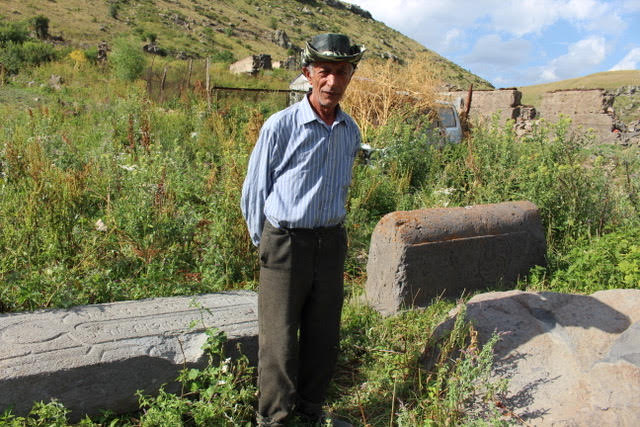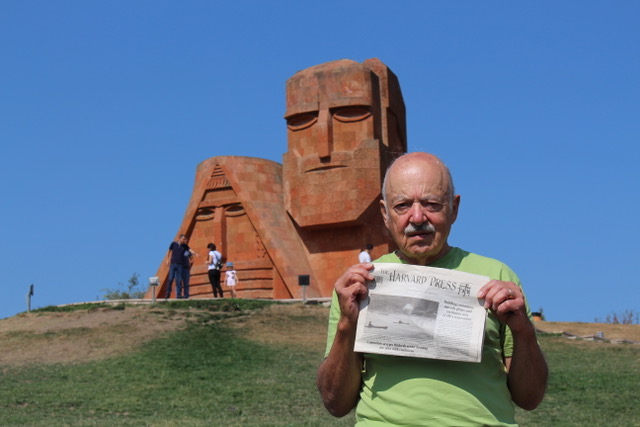Vayots Dzor
Traveling south from Yerevan towards Artsakh, after passing through Ararat province, the main highway enters Vayots Dzor. Shortly thereafter there is the village of Areni, famous for its wine, and where the world’s oldest shoe was found in a cave. Nearby is the spectacular Noravank Monastery.
Vayots Dzor has an abundance of other sites of scenic beauty and historical significance, such as the 14th century Spitakavor monastery near the village of Vernashen. In 1987, during the Soviet era, the remains of Armenian hero and freedom fighter Karekin Nejdeh were secretly smuggled onto this site from the Soviet prison camp where he died and re-interred in his sacred Armenian soil. From near the monastery, the fortress of Boloraberd/Proshaberd is clearly visible and accessible to hikers.

This region is also home to Smbataberd, an impressive fortress which was considered impregnable, sitting atop a mountain with a spectacular view and command of the surrounding valleys and villages. A narrow dirt and gravel road, with the valley below to the right, leads to the fortress. We ascended to the fort in a four wheel drive Niva, but there is no room for error here and no room to turn around if another vehicle approaches from the opposite direction. At the summit of the hill near the entrance to the fort, however, there is room to turn around. Invading Turks, unable to capture this fort militarily, took the fort by interrupting its water supply.

There are a number of other interesting sites nearby accessible by car. In the beautiful village of Yeghegis are a number of churches, the most unusual being Sp. Zorats Cathedral, 1303—a unique open air church. Armenian cavalry detachments would attend church service on horseback, facing the altar from the field in front of the church. They and their weapons would receive blessings before riding off to battle. During medieval times this area was under the jurisdiction of the Orbeli dynasty, which produced a number of outstanding clergymen, diplomats, military leaders and scholars.
Getikvank
My map of Armenia showed a road ascending the local heights following the course of the Yeghegis River ending at Getikvank, with a church icon on my map marking the end of the road. A poor but passable dirt road brought us to the destroyed village which, for a long time, remained uninhabited. From spring until fall, however, local villagers encamp here in this “yayla” with their families, pasturing their livestock on nearby fields. Most of the families are from Shatin, a nearby village with the scenic Shativank monastery in the hills above the village. In the “yayla,” there were women sitting in the shade of a stone wall; they initially declined to be photographed, until I convinced them that I was dressed worse than them. Children were playing; a young boy posed for me while his older cousin kept an eye on him. A gentleman from Shatin with an interest in this region’s history took me to the few stones that remained from the church’s foundation. The church was surrounded by beehives to the left and yeghinj (stinging nettle plants) to the right. I chose passage through the nettle; at least the nettle would not fly after me to sting me repeatedly! Nearby were some tombstones, including those of clergymen. The date and name of the church are unknown, but the village historian indicated that this was probably from the dawn of Armenian Christianity – perhaps from the fourth century.
Much of this area was emptied of Armenians around 1604 by Persian Shah Abbas’ decree to forcibly deport Armenians to Persia; a scorched earth policy intended to prevent Turkish invaders from living off the land and its Armenian population during Turkish–Persian conflicts to dominate this area. Without Armenians, Armenian monuments were neglected or vandalized when Turkish tribes moved in. Later, the Treaty of Turkmanchi (1828) between Persia and Russia, allowed Armenians whose families were forcefully deported to Persia to return home. As Armenians returned, many Turks and other non-Armenians moved out. The Russian writer and diplomat who helped negotiate the right of return, Aleksander Griboyedov, is credited with helping to restore the Armenian population here. He was subsequently murdered by a Persian mob. He is a hero in Armenia; there’s a statue of him on Tigran Mets street in Yerevan. There’s also a village named after him.
In a nearby village one resident indicated that his ancestors came from Persia (Iran). “But,” he insisted, “we’re not Barsgahyes!” (we’re not Persian-Armenians), signifying his ancestors were from this area, forcefully deported to Persia, with subsequent generations of his family returning to Armenia.
Retreat from Avarayr

Pointing to the mountains about 40 kilometers to the northeast, our village historian in Getikvank indicated that there were graves of Vartan Mamikonian’s soldiers there who survived the Battle of Avarayr (451 AD) and were withdrawing towards Artsakh. He indicated that in his youth he hiked there and saw the gravesites. As far as I know, there have been no archaeological investigations of that site. But, according to a number of medieval histories, survivors from Avarayr, pursued by Persians, retreated through this area.
Stepanos Orbelian (1250-1303), in his “History of Sisakan” (excerpt of translation by Robert Bedrosian below), relates how Armenian survivors of Avarayr were relentlessly pursued by Persians as the Armenians were seeking safety. The nearby Tsaghatskar (Tsakhatskar) monastery originally was a memorial built on or near the site of the slaughter of Avarayr warriors. Historian Stepanos Orbelian states:
“[The Persians] advanced farther and killed 300 more [Christians] by the waters located between [the villages] called Ostink’ and Artaboynk.’ Subsequently the residents of the area built a church over this spot. Then the Persians crossed a gorge on the left, overlooking the holy convent called Ts’aghats’k’ar, situated on an elevation between the two villages mentioned above, and there they massacred a very large number of sepuhs and elite warriors.”

Artaboynk village is in a mountainous area which surely must have been an attractive site from which to present a military defense. Also our village historian told us of a nearby monument dedicated to Vartan and his soldiers. It was not clear if this was an ancient monument or a more recent one, but we were unable to find it.
The Vartanantz War
The Vartanantz War with Persia was fought over the right of Armenia to remain a Christian nation. Armenia was refusing to obey Persian demands to abandon Christianity and convert to Zoroastrianism. Mamikonian, the hereditary commander in chief of Armenian forces, was killed in the Battle of Avarayr and subsequently sainted. The numerically smaller Armenian army, however, inflicted disproportionately large casualties on the Persian forces but lost the battle. Armenians continued to wage a guerrilla war for decades under the leadership of Kayl Vahan (Wolf Vahan), the nephew of Vartan. The conflict ended with the Treaty of Nvarsak (484 AD) which guaranteed Armenia religious freedom, the first known treaty to guarantee freedom of religion. The Mamikonians continued as hereditary commanders of Armenia’s armed forces, though Armenia continued to pay tribute to Persia in the form of taxes and military service.



I have been living in Armenia my whole life but still never heard about Getikvank. I always thought that Armenia is very Yerevan oriented. We have so many beautiful sights, but even native Armenian do not know about these places. Armenia is full of ancient cathedrals and monasteries, tiny beautiful villages with mindblowing nature. Wonderful places like Avarayr and Getikvank stay unseen because all the investments are being made in the Yerevan. In my personal perspective, the time for developing such sites has come, that would be very beneficial for Armenia. People living in those areas will have proper jobs, and more tourists will come to Armenia.
I greatly appreciate these articles by Mr. Daghdigian.
I bet many people who live in Yerevan have never been to any of these places.
Armenia and Artsakh should have many more tourists. There should be explicit Christian tours.
Hats off to Joe for creating a terrific awareness of
The many historic sites in our Armenian homeland. During my three trips to Armenia, I especially enjoy excursions to the country side.
I had the good fortune of witnessing a slide presentation by Hovsep Dagdigian in NYC. There I observed where Kevork Chavoush had his last stand and where vartan mamigonian prayed before going into battle, among many other notable places visited by and reported upon by Hovsep. How else but through the few on-the -ground record-keepers and village historians that are left — and reportage by Hovsep — would we know such things?
We have many volunteers doing important work for the Armenian nation. Hovsep heads that list by performing this unique and necessary service.
The towns and villages if Armenia and Artsakh need our support, investment, tourism, development and moral support far more than Yerevan does!
Fantastic! I’m keeping track of these places for when I retire and can spend lots of time in Armenia. Joe you are our eyes and ears and longing hearts to be there.
One must talk about some places in Syunik as well. There are a lot of beautiful and historical views which are unexplored. I used to travel Syunik when I was a child because my grandmother had a house there. While talking about Syunik, the first thing which comes to our mind is probably the Tatev monastery. However, when there’s no ropeway, no one cared about a significant historical value of Tatev. Hence, after building the ropeway, people of Tatev started to live more or less well, since there are new workplaces and touristic opportunities. But where my grandmother’s house is located, there is no special ropeway or something which can attract tourists. And hence, people live in a parallel reality with the worst conditions of life. There are no workplaces, and the only thing that they can do is some agricultural stuff which is not that much profitable and constant. So what is the moral of my story, there are a lot of places in Armenia which are underrated, but they can be excellent touristic places.
We visited Armenia last year and loved it. I wish I had seen this article before going and will be sure to add some of these more off the beaten path destinations next time we go!